 On January 9, 2013, we posted about the Seastreak Wall Street catamaran ferry, which slammed into a loading barge at Pier 11 in New York City’s East River in Lower Manhattan at 12 knots, injuring 80 of the 331 passengers and crew. The 140 feet long and 30 feet wide ferry was operating on scheduled service from Atlantic Highlands and Conners Highlands in New Jersey to Lower Manhattan. The National Transportation Saftey Board (NTSB) recently released its findings on the accident, which found that the action was caused the captain losing control of the ferry as it approached the dock, complicated by poor bridge design and lax management over-site of ferry operations.
On January 9, 2013, we posted about the Seastreak Wall Street catamaran ferry, which slammed into a loading barge at Pier 11 in New York City’s East River in Lower Manhattan at 12 knots, injuring 80 of the 331 passengers and crew. The 140 feet long and 30 feet wide ferry was operating on scheduled service from Atlantic Highlands and Conners Highlands in New Jersey to Lower Manhattan. The National Transportation Saftey Board (NTSB) recently released its findings on the accident, which found that the action was caused the captain losing control of the ferry as it approached the dock, complicated by poor bridge design and lax management over-site of ferry operations.
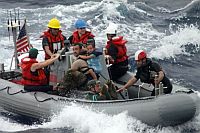
Photo:AP
I will admit to having distinctly mixed feelings related to the rescue of the Kaufman family on their yacht ‘Rebel Heart.‘ I am obviously pleased that Lyra received medical attention. I am saddened that the boat that was their home was lost. I am impressed by the skill, expertise and the resources marshaled by the California Air National Guard, the US Navy and the US Coast Guard. All these responses are fairly obvious and non-controversial. The larger question is harder to answer. KJ Dell’Antonia writes about it in the Motherlode blog in yesterday’s New York Times. The blog post is titled, “Judge the ‘Rebel Heart’ Sailboat Parents, or Envy Them?” In some respects the answer may be, both.
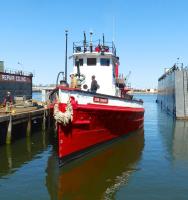
Photo: Will Van Dorp
Yesterday, we posted about the arrival of the World War II Destroyer Escort USS Slater at Caddell Dry Dock. The day before, the historic fireboat, John J. Harvey, left Caddell to return to her Hudson River dock after a month of refurbishment. The fireboat built in 1931, was drydocked, repaired, painted and had two new stacks installed. She’s looking good.
Our referrence to her as “an American treasure” is more than just metaphor. The John J. Harvey has been awarded the prestigious Federal Save America’s Treasures Grant. This grant will provide matching funds of $165,955, provided that the organization can raise an equal sum by the end of the year. So far $142,000 toward the total Save America’s Treasures matching grant has been raised. If you can help to put them over the top, please donate here.
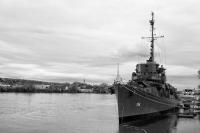
Photo: Michael Sheehan
Could the arrival of the the USS Slater, the last World War II destroyer escort still afloat in the United States, be a sign of spring in New York harbor? We can only hope, although as the sky today remains about as gray as her paint, perhaps that might be too optimistic. The old ship was towed down the Hudson River from her usual home in Albany by the tug Marigot and arrived at Caddell Dry Dock in Staten Island this morning for drydocking and repair. She was originally scheduled to go into the yard in February, but heavy ice on the Hudson kept her alongside her dock. The Slater‘s drydocking and repairs are being funded entirely by private donations.
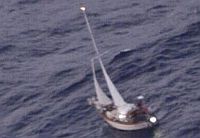
Photo: 129th Rescue Wing
Update: As reported by CBS — The Coast Guard says the baby, along with her parents and 3-year-old sister, boarded the USS Vandegrift at 8 a.m. Sunday. The baby girl was in stable condition and was heading to San Diego for medical treatment.
On Thursday, four pararescuers from the California Air National Guard 129th Rescue Wing parachuted to the 36′ sailboat, Rebel Heart, in the Pacific roughly 900 nautical miles off the coast of Cabo San Lucas, Mexico. The pararescuers helped stabilize a seriously ill one year old infant girl aboard the sailboat. USS Vandegrift, an Oliver Hazard Perry-class frigate, was dispatched from San Diego and traveled at close to 30 knots to reach the sailboat. The Vandegrift is equipped with an inflatable boat and a helicopter, but no decision has been made yet about the mode of transfer until officials can evaluate the sea conditions and other factors, said Lt. Lenaya Rotklein of the U.S. Third Fleet.
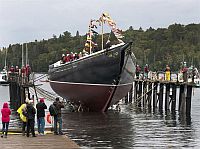
Photo: Andrew Vaughan
The new construction/restoration of the Canadian schooner Bluenose II has not gone well. Years behind schedule and millions over budget. Nova Scotia Premier Stephen McNeil is calling it a “boondoggle” and is demanding an investigation into the project. Recent lawsuits involving the schooner have cost more in legal fees alone than the cost of the original Bluenose II in 1963. The total cost of the current project is $16.7 million dollars and expected to rise still further.
Sailors watching the sky will see a total lunar eclipse on April 15th in the United States. This is the beginning of a rare tetrad, a sequence of four total lunar eclipses, each six months apart. While this will be one of nine tetrads occurring this century, in the three hundred years between 1600 and 1900, there were no lunar tetrads at all. The total eclipse of April 15, 2014, will be followed by another on Oct. 8, 2014, and another on April 4, 2015, and another on Sept. 28 2015. This video by NASA summarizes what to expect.
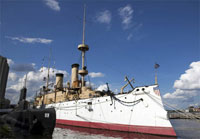 After a three year bidding process to attempt to find a new home for the historic cruiser Olympia, the Independence Seaport Museum has announced that it will keep the ship after all.
After a three year bidding process to attempt to find a new home for the historic cruiser Olympia, the Independence Seaport Museum has announced that it will keep the ship after all.
Four groups originally bid on taking over the ship but none were considered to be viable. The museum also noted that the ship was responsible for half of the museum’s 70,000 annual visitors. Museum president John Brady has announced a $20-million national fundraising campaign to support repairs to the cruiser. The museum had previously claimed that it could not afford to keep the historic ship.
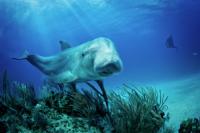
The illusive manaphin
Yesterday was April 1st, often known as April Fool’s Day. (Our post on a dramatic man overboard rescue was definitively not a spoof.) Yesterday “Visit St Pete-Clearwater” issued a press release about a recent sighting of the legendary “Manaphin” in the Gulf of Mexico, just off the coast of Pinellas County, Florida. The manaphin is a dolphin-manatee hybrid, according to the press release and an associated Manaphin web site. From the press release:
Kayaker Doug Lamal was about 20 yards from shore last Friday afternoon when the creature’s distinctive head broke the surface of the water. “I’ve seen both manatees and dolphins many times,” said the 34-year old Chicagoan. “But this was different—the thing moved like a dolphin but had the head of a manatee. It was pretty cool.”
Andrew Taylor, 46, from London, a crew member on Derry~Londonderry~Doire yacht, racing in the Clipper Round the World Race, went overboard in the Pacific at 23.43 UTC Sunday night in rough weather. He was sighted again at 00.55 UTC before being recovered at approx. 01.13 UTC (13.13 local time, 30 March). Dramatic footage of the rescue has been posted on Youtube:
Derry~Londonderry~Doire successfully recovers man overboard during Clipper Round the World
From the Clpper Round the World website:
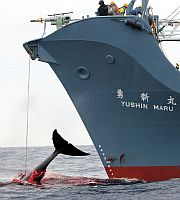 Great news. The UN’s highest court has ruled against Japanese Antarctic whaling. The Japanese have notionally supported the commercial whaling moratorium adopted in 1982 but have exploited a loophole which allows for whaling for “scientific research.” As we posted last June, the the government of Australia, supported by New Zealand, filed a suit asking the International Court to halt the Japanese whaling fleet’s annual trips to harpoon minke and fin whales. Today, the International Court of Justice at the Hague ordered a temporary halt to Japan’s Antarctic whaling program, ruling that it is not for scientific purposes as the Japanese government had claimed. As reported by CBC News:
Great news. The UN’s highest court has ruled against Japanese Antarctic whaling. The Japanese have notionally supported the commercial whaling moratorium adopted in 1982 but have exploited a loophole which allows for whaling for “scientific research.” As we posted last June, the the government of Australia, supported by New Zealand, filed a suit asking the International Court to halt the Japanese whaling fleet’s annual trips to harpoon minke and fin whales. Today, the International Court of Justice at the Hague ordered a temporary halt to Japan’s Antarctic whaling program, ruling that it is not for scientific purposes as the Japanese government had claimed. As reported by CBC News:
Reading a 12-4 decision by the court’s 16-judge panel, Presiding Judge Peter Tomka said Japan’s program fails to justify the large number of minke whales it says it needs to catch under its current Antarctic program — 850 annually — and it doesn’t catch that many anyway. It also didn’t come close to catching the 50 fin and 50 humpback whales it aimed to take… All that drew into doubt Japan’s assertion that its whaling is for scientific purposes, he said…
“The court concludes that the special permits granted by Japan for the killing, taking, and treating of whales … are not ‘for purposes of scientific research’,” Tomka said.
Japan said it would abide by the ruling but added it “regrets and is deeply disappointed by the decision”. Norway and Iceland continue to engage in commercial whaling in violation of the moratorium.

Image: Hobie.com
Hobart “Hobie” Alter died of cancer in Palm Desert, California on March 29th, 2014 at the age of 80. In 1958, he revolutionized surfboard design by developing the foam-and-fiberglass surfboard. In the 1960s, he introduced multi-hull sailing to the mass market with the Hobie Cat, eventually offering 13 different models. Over 135,000 Hobie 16 catamarans are sailing around the world. Alter also designed the Hobie 33, an ultralight displacement monohull sailboat. He also designed skateboards and the “Hobie Hawk,” a radio controlled glider. Alter sold Hobie Cat to the Coleman Company, Inc. in 1976. His sons, Hobie Jr. and Jeff, carry on the family tradition, operating Hobie Designs and overseeing the company’s licensing operations. Hobie Cats are currently manufactured in five different countries around the world.
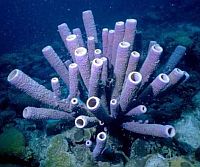 All terrestrial life came from the sea, but how did life develop in the ocean? Professor Tim Lenton of the University of Exeter, who led a new study, said: “There had been enough oxygen in ocean surface waters for over 1.5 billion years before the first animals evolved, but the dark depths of the ocean remained devoid of oxygen. We argue that the evolution of the first animals could have played a key role in the widespread oxygenation of the deep oceans. This in turn may have facilitated the evolution of more complex, mobile animals.”
All terrestrial life came from the sea, but how did life develop in the ocean? Professor Tim Lenton of the University of Exeter, who led a new study, said: “There had been enough oxygen in ocean surface waters for over 1.5 billion years before the first animals evolved, but the dark depths of the ocean remained devoid of oxygen. We argue that the evolution of the first animals could have played a key role in the widespread oxygenation of the deep oceans. This in turn may have facilitated the evolution of more complex, mobile animals.”
And what were these animals that oxygenated the oceans? Sponges, according to the the new research. Sponges may lack the brains and other organs of more complex animals, but they are animals nonetheless, and around 700 million years ago, sponges began to flood the oceans with oxygen. The oceans had had relatively little oxygen and could not support more complex life.
 Sarah Kirby went on a five night Caribbean cruise on the Carnival Destiny to celebrate her 30th birthday in October of 2012. Partying with friends, she became very intoxicated. Just after midnight, she went back to her stateroom and stepped out on to her cabin balcony to get some air. Somehow, she managed to fall or climb over the 45″ high railing, tumbling seven decks, roughly 100′, to the water, striking a life raft on the way down. Kirby is quoted as saying, ‘I remember leaning over the balcony to look at the side of the ship and next thing I knew I was in the water.‘ Two hours later she was rescued from the water by the ship’s crew.
Sarah Kirby went on a five night Caribbean cruise on the Carnival Destiny to celebrate her 30th birthday in October of 2012. Partying with friends, she became very intoxicated. Just after midnight, she went back to her stateroom and stepped out on to her cabin balcony to get some air. Somehow, she managed to fall or climb over the 45″ high railing, tumbling seven decks, roughly 100′, to the water, striking a life raft on the way down. Kirby is quoted as saying, ‘I remember leaning over the balcony to look at the side of the ship and next thing I knew I was in the water.‘ Two hours later she was rescued from the water by the ship’s crew.
She is now suing Carnival for negligence and intentional infliction of emotional distress. She claims that the bartender “pushed drinks on her,” and that Carnival delayed rescuing her from the water. Carnival denies the allegations saying that the claims ‘are completely unsupported and contradicted by the evidence in the case.‘ The lawsuit made a large splash in the media in January when infrared CCTV video emerged of the fall. (See the video after the page break.)
Without expressing an opinion about the specifics of the lawsuit, it does raise several important questions. Are balconies, booze and drunken passengers inherently tragedies waiting to happen? Are the cruise lines doing enough to keep their passengers on board and doing enough when they fall overboard? Specifically, why haven’t cruise lines installed “Man Overboard Detection Systems” as mandated by the Cruise Vessel Security and Safety Act of 2010?
Back in 2011, we posted about Kick’em Jenny, which in addition to being the name of a rockabilly singer as well as a Dutch Celtic Symfo-Folk group, is an active underwater volcano in the Lesser Antilles about 5 miles north of the island of Grenada.
Kick’em Jenny rises 4,265 ft above the sea floor on the steep inner western slope of the Lesser Antilles ridge. The volcano has erupted on at least twelve occasions between 1939 and 2001. The dome of the volcano is approximately 180 meters (590 feet) below the surface of the Caribbean. Kick’em Jenny was last surveyed in 2003. Last October, researchers sent an ROV into the volcano to see what had changed over the last decade. The video below is a fascinating journey into the volcano, with commentary by Dr. Steve Carey, Chief Scientist on the E/V Nautilus. For more videos of Kick-em-Jenny and other submarine wonders go to Exploration Now.
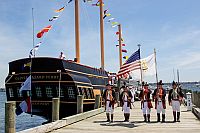
Photo: Kim Fuller
The April Smithsonian Magazine features photos of the SSV Oliver Hazard Perry and an article titled “Building a War of 1812 Warship.” One can only imagine what Oliver Hazard Perry would have thought of the new ship that bears his name. After having had the Lawrence, his first ship at the Battle of Put-in-Bay in 1813, shot out from under him, he would certainly appreciate the new ship’s steel hull. The twin engines and bow thruster, hidden beneath the waterline, would have amazed him and the electronics would have surely seemed like black magic, (which at times, I believe they are.)

Photo by Al-Alam
Lights, camera, mock aircraft carrier. We posted the other day about a strange mock Nimitz aircraft carrier apparently under construction in an Iranian shipyard. The Iranian-owned Al-Alam News Network is reporting that the mock-up is being built for a film titled “Airbus,” about the 1988, downing of civilian passenger plane Iran Air Flight 655 by the USS Vincennes. The film is reported to be a joint Iranian-Canadian production, being co-directed by Nader Talebzadeh and Paxton Winters and will star both Iranian and American actors, most prominently Sean Ali Stone, the son of American filmmaker Oliver Stone. It is unclear what role a mock aircraft carrier would play in the account of the shooting down of the passenger plane by a US guided missile cruiser.
 It appears that the British satellite firm, Inmarsat, combined high tech analysis with very basic navigation to estimate the flight path of MH370, after all other other searchers had failed to find the plane.
It appears that the British satellite firm, Inmarsat, combined high tech analysis with very basic navigation to estimate the flight path of MH370, after all other other searchers had failed to find the plane.
The Prime Minister of Malaysia announced yesterday that Flight MH370 had crashed in a remote area of the Indian Ocean with no survivors. Debris, which may be from the 777 jet liner which disappeared on March 8th, has been sighted by satellite imagery and by search planes. So far, however, no debris has been recovered as a cyclone in the area has turned back ships attempting to collect and identify the debris.
So how did Inmarsat locate the probable flight path of the doomed jet-liner? Continue reading
 On March 24, 1989, the 210,000 dwt crude oil tanker Exxon Valdez sailed from Valdez Marine Terminal and entered Alaska’s Prince William Sound. At 12:04 am, the single hulled ship ran aground on Bligh Reef, resulting in the largest oil spill in United States history, prior to the Deepwater Horizon disaster. Between 260,000 to 750,000 barrels (41,000 to 119,000 m3) of crude oil spilled into the Sound. The oil eventually covered 1,300 miles (2,100 km) of coastline, and 11,000 square miles (28,000 km2) of ocean.
On March 24, 1989, the 210,000 dwt crude oil tanker Exxon Valdez sailed from Valdez Marine Terminal and entered Alaska’s Prince William Sound. At 12:04 am, the single hulled ship ran aground on Bligh Reef, resulting in the largest oil spill in United States history, prior to the Deepwater Horizon disaster. Between 260,000 to 750,000 barrels (41,000 to 119,000 m3) of crude oil spilled into the Sound. The oil eventually covered 1,300 miles (2,100 km) of coastline, and 11,000 square miles (28,000 km2) of ocean.
 Sylvia Earle is an American marine biologist, explorer, author, and lecturer. In her illustrious career she has earned many honors, including being named by Time Magazine as as its first Hero for the Planet in 1998. She is National Geographic’s explorer-in-residence, as well as a member of the National Women’s Hall of Fame and a Knight in the Netherlands’ Order of the Golden Ark. She was recently recognized in a very different venue. Sylvia Earle now has a LEGO figurine modeled after her.
Sylvia Earle is an American marine biologist, explorer, author, and lecturer. In her illustrious career she has earned many honors, including being named by Time Magazine as as its first Hero for the Planet in 1998. She is National Geographic’s explorer-in-residence, as well as a member of the National Women’s Hall of Fame and a Knight in the Netherlands’ Order of the Golden Ark. She was recently recognized in a very different venue. Sylvia Earle now has a LEGO figurine modeled after her.
The first thing you should know about Sylvia Earle is that she has a LEGO figurine modeled after her. One that has little yellow flippers instead of little yellow feet.
